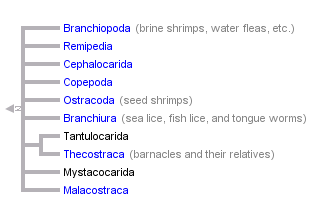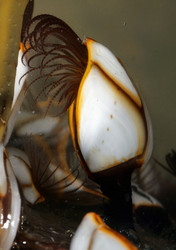Crustacea
Crabs, lobsters, shrimp, barnacles, sow bugs, etc.



This tree diagram shows the relationships between several groups of organisms.
The root of the current tree connects the organisms featured in this tree to their containing group and the rest of the Tree of Life. The basal branching point in the tree represents the ancestor of the other groups in the tree. This ancestor diversified over time into several descendent subgroups, which are represented as internal nodes and terminal taxa to the right.

You can click on the root to travel down the Tree of Life all the way to the root of all Life, and you can click on the names of descendent subgroups to travel up the Tree of Life all the way to individual species.
For more information on ToL tree formatting, please see Interpreting the Tree or Classification. To learn more about phylogenetic trees, please visit our Phylogenetic Biology pages.
close boxReferences
Abele, L. G., T. Spears, W. Kim, and M. Applegate. 1992. Phylogeny of selected maxillopodan and other crustacean taxa based on 18S ribosomal nucleotide sequences: a preliminary analysis. Acta Zoologica 73:373-382.
Boxshall, G. 1998. Comparative limb morphology in major crustacean groups: the coxa-basis joint in postmandibular limbs. Pages 155-167 in Arthropod Relationships. R. A. Fortey and R. H. Thomas, eds. Systematics Association Special Volume Series 55. Chapman & Hall, London.
Boxshall, G. 2007. Crustacean classification: on-going controversies and unresolved problems. Pages 313-325 in: Zhang, Z.-Q. & Shear, W.A., eds. Linnaeus Tercentenary: Progress in Invertebrate Taxonomy. Zootaxa 1668:1766.
Chen, J. Y., J. Vannier, and D. Y. Huang. 2001. The origin of crustaceans: new evidence from the Early Cambrian of China. Proceedings of the Royal Society of London Series B 268:2181-2187.
Lavrov, D. V., W. M. Brown, and J. L. Boore. 2004. Phylogenetic position of the Pentastomida and (pan)crustacean relationships. Proceedings of the Royal Society London Series B 271:537-44.
Martin, J. W. and G. E. Davis. 2001. An updated Classification of the Recent Crustacea. Natural History Museum of Los Angeles County Science Series 39. Los Angeles, CA.
Regier, J. C., J. W. Shultz, and R. E. Kambic. 2005. Pancrustacean phylogeny: hexapods are terrestrial crustaceans and maxillopods are not monophyletic. Proceedings of the Royal Society Series B 272(1561):395-401.
Richter, S. 2002. The Tetraconata concept: hexapod-crustacean relationships and the phylogeny of Crustacea. Organisms Diversity & Evolution 2:217-237.
Schram, F. (ed.) 1983. Crustacean Phylogeny. A. A. Balkema, Rotterdam.
Schram, F. 1986. Crustacea. Oxford University Press, New York, Oxford.
Schram, F. and C. H. J. Hof. 1998. Fossils and the interrelationships of major crustacean groups. Pages 233-302 in Arthropod Fossils and Phylogeny. G. D. Edgecombe, ed. Columbia University Press, New York.
Spears, T. and L. G. Abele. 1998. Crustacean phylogeny inferred from 18S rDNA. Pages 169-187 in Arthropod Relationships. R. A. Fortey and R. H. Thomas, eds. Systematics Association Special Volume Series 55. Chapman & Hall, London.
Spears, T. and L. G. Abele. 1999. The phylogenetic relationships of crustaceans with foliaceous limbs: an 18S rDNA study of Branchiopoda, Cephalocarida, and Phyllocarida. Journal of Crustacean Biology 19:825-843.
Walossek, D. and K. J. Müller. 1998. Cambrian 'Orsten'-type arthropods and the phylogeny of Crustacea. Pages 139-153 in Arthropod Relationships. R. A. Fortey and R. H. Thomas, eds. Systematics Association Special Volume Series 55. Chapman & Hall, London.
Whittington, H. B. and W. D. U. Rolfe (eds.). 1963. Phylogeny and Evolution of Crustacea. Museum of Comparative Zoology, Cambridge.
Wills, M.A. 1998. A phylogeny of Recent and fossil Crustacea derived from morphological characters. Pages 189–209 in Arthropod Relationships. R. A. Fortey and R. H. Thomas, eds. Systematics Association Special Volume Series 55. Chapman & Hall, London.
Information on the Internet
- crustacea.net. An information retrieval system for crustaceans of the world. Australian Museum online.
- The Crustacean Society
- Crustacea at the Natural History Museum of Los Angeles County.
- Marine Crustaceans of Southern Australia. Museum Victoria.
Title Illustrations

| Scientific Name | Daphnia pulex |
|---|---|
| Source | Daphnia pulex |
| Source Collection | BIODIDAC |
| Copyright | © Jean-François Cornuet |
| Scientific Name | Grapsus grapsus |
|---|---|
| Location | Santa Cruz Island (Isla Santa Cruz), Galapagos Island, Ecuador |
| Specimen Condition | Live Specimen |
| Source | Sally Lightfoot Crab (Grapsus grapsus) |
| Source Collection | Flickr |
| Image Use |
 This media file is licensed under the Creative Commons Attribution-NonCommercial License - Version 2.0. This media file is licensed under the Creative Commons Attribution-NonCommercial License - Version 2.0.
|
| Copyright | © 2008 David Cook Wildlife Photography |
| Scientific Name | Lepas anatifera |
|---|---|
| Location | North Carolina |
| Specimen Condition | Live Specimen |
| Behavior | filter-feeding |
| Source | Pelagic goosneck barnacle |
| Source Collection | Flickr |
| Image Use |
 This media file is licensed under the Creative Commons Attribution-NonCommercial-ShareAlike License - Version 2.0. This media file is licensed under the Creative Commons Attribution-NonCommercial-ShareAlike License - Version 2.0.
|
| Copyright |
© 2008 Patrick Coin

|
About This Page
Page copyright © 2002
All Rights Reserved.
Citing this page:
Tree of Life Web Project. 2002. Crustacea. Crabs, lobsters, shrimp, barnacles, sow bugs, etc.. Version 01 January 2002 (temporary). http://tolweb.org/Crustacea/2529/2002.01.01 in The Tree of Life Web Project, http://tolweb.org/











 Go to quick links
Go to quick search
Go to navigation for this section of the ToL site
Go to detailed links for the ToL site
Go to quick links
Go to quick search
Go to navigation for this section of the ToL site
Go to detailed links for the ToL site